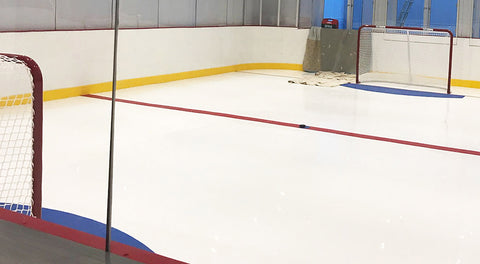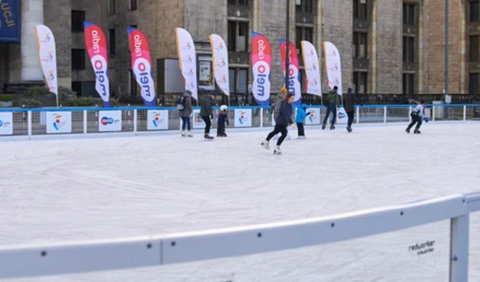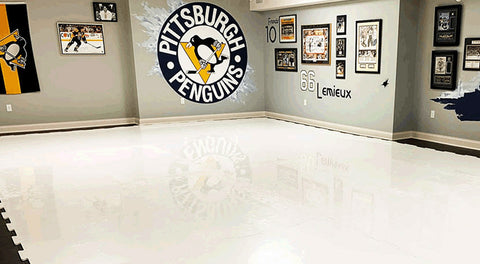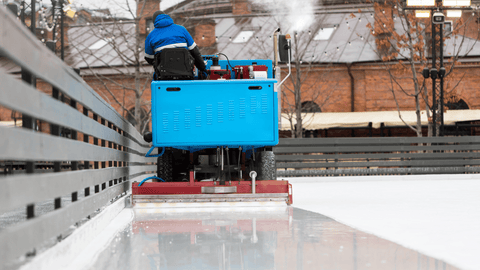Slide Board Therapy: A Comprehensive Guide For All Injuries (2025)
Have you ever heard of slide board therapy?
If you’re recovering from an injury, this might be the game-changer to get you moving and grooving again.
Joint, tissue, and muscle injuries are a part of life.
If you’re an active person, like many of our hockey players and figure skaters, you’ll likely experience sprains, strains, and other soft tissue mishaps.
In some unfortunate circumstances, an ACL tear, rotator cuff tear, Achilles rupture, knee surgery or broken bone can keep you on the sidelines for months.
Injuries aren’t only an athlete’s concern and no one is ammune.
And let’s not even talk about arthritis, which is general wear and tear of your joints.
Make The Most Of Your Rehab Therapy WIth A Glide-Infused Slip Board By PolyGlide Ice
We’re not doctors, but one thing is certain: acute or chronic injuries require treatment (sometimes surgery) and a degree of recovery.
During your recovery, you will probably need physical therapy, which involves a series of stretches, exercises, and movements to strengthen the muscles, tendons, or ligaments impacted by the injury.
Physical therapy is also becoming more innovative, with tools like cryotherapy, massage guns, compression, and oxygen therapy becoming more commonplace.
Recently, we’ve noticed more athletes and people with chronic injuries use slide boards to help with recovery through therapy.
These were initially designed to simulate ice skating for off-ice training.
However, this versatile device has now become useful for exercise and recovery in the form of slide board therapy.
7 Innovative Uses for Slideboards
A slideboard is a rectangular piece of equipment for ice skating training exercises.
Slideboards require booties or other soft covering over the feet, allowing the user to glide from one end to the other.
The original slideboards consist of wood or plastic.
Now, slideboards are made with many different types of polymer products.
They are also useful as an exercise tool, becoming popular among fitness influencers because they have low impact and are great for the joints.
Slideboards can also help with recovery from injury.
After the first two weeks of surgery, a patient with a lower leg injury, for instance, can begin resistance exercises.
These exercises increase in intensity over time.
Slideboards help therapists and patients by being a fantastic, low-impact exercise.
Here are a few benefits of slide board therapy:

1. Slideboards Improve Range of Motion
One goal of physical therapy is to restore the patient’s range of motion (ROM) to an injured joint.
At the end of therapy, the joints should be able to move in all possible directions without severe pain.
ROM exercises are also essential during recovery to prevent muscle and joint stiffness.
By performing exercises on a slideboard, you can engage a broader range of muscles and joints, leading to improved flexibility and mobility.
In addition, a slideboard helps by providing a smooth, gliding surface to perform exercises that promote stretching and movement.
For example, you can use a slideboard to perform lateral lunges, which help stretch the inner and outer thighs while working the glutes and hip muscles.
In addition, sliding side-to-side on the board can help extend the hips and lower back, which can be especially beneficial for those with a leg injury.
As there is no impact, incorporating slideboard ROM exercises allows maximum use of the affected joint with minimal pain.
2. Reduce Swelling and Pain While Building Muscle Strength
Swelling is a common side effect of injury or surgery.
The body produces inflammation to help with healing while reducing the chances of infection.
However, too much swelling is counterproductive and often happens due to pressure placed on the affected area.
Because you’re not running or jumping, slideboards can strengthen the muscles around the injured area to minimize swelling and pain while promoting the healing of tissue damage.
These benefits enable even those with severe injuries to begin rehabilitation sooner.
After a joint or muscle injury, it is common for the muscles in the affected area to become weakened due to underuse and immobilization.
A slideboard provides a low-impact way to strengthen the surrounding muscles, which is crucial to recovery.
Using a slideboard to perform exercises like lunges, squats, and leg curls can target the muscles in the legs and hips.
In addition, slideboard pushups and side-to-side movements can help with arm, shoulder, or other upper-body injuries.
By performing these exercises with the help of a slideboard, you can maintain a low-impact approach that minimizes the risk of further damage and swelling while effectively strengthening the muscles.

3. Increases Flexibility
Flexibility is essential during the recovery process to prevent injury and maintain mobility.
Unfortunately, when you’ve been injured, your muscles and joints can become stiff and inflexible due to immobilization or lack of movement.
This can cause pain and hinder your ability to perform everyday activities.
Using a slideboard can help to improve flexibility by engaging the muscles and joints in a low-impact, controlled manner.
The sliding motion allows you to move your joints through a full range of motion, which can help to prevent stiffness and improve flexibility.
This can also help to increase blood flow and promote healing by bringing fresh nutrients and oxygen to the injured area.
4. Provides Low Impact Exercise
A significant benefit of using a slideboard during leg injury recovery is that it provides a low-impact exercise option.
High-impact exercises, such as running or jumping, can put too much stress on the legs, slowing recovery or leading to further injury.
A slideboard can offer a gentler, low-impact alternative to the muscles and joints.
This is crucial for surgeries with an in-between period after removing the stitches.
You feel good enough to move but realize you aren’t strong enough to perform most exercises.
Sliding side-to-side on the board can provide a low-impact cardiovascular workout that promotes circulation and helps overall recovery.
Incorporating low-impact exercises with a slideboard into your recovery routine can help you maintain fitness and improve your overall health while recovering from a leg injury.

5. Offers Variety in Your Routine
The hardest part about physical therapy recovery is the repetitiveness of it all.
You need to perform the same movements several times a week for several weeks to feel better.
These aren’t explosive movements but slow, tedious steps to strengthen your body.
Variety in your therapy is essential to help keep you engaged and motivated throughout the recovery process.
A slideboard can offer various exercises that challenge your body differently.
The exercises that can be performed on a slideboard are versatile. Many can be adapted to target different muscle groups and fitness goals.
For example, you can use a slideboard to perform lateral lunges, squats, hamstring curls, and pikes, among other exercises.
You can vary the intensity and duration of each exercise to create a customized workout that meets your specific needs.
6. Slideboards encourage movement
Slideboards are convenient and easy to use.
They can also be stored in small spaces and can be carried easily.
Even with minimal floor space, you can set up a slideboard for your workout.
A single board can encourage you to do different exercises, from lying down, sitting down, and standing up.
This level of convenience can help you receive therapy cheaper and at your earliest convenience.
7. Helps burn more calories
Gliding through the slideboard can help you burn more calories and lose weight.
You can also do pushups, lunges, and mountain climbers on it to add more variety to your workout and burn even more calories.
A 20-minute exercise can burn up to 300 calories, as managing weight is essential to recovery.
To achieve better results, you can do the exercises faster while using the slide board to increase the intensity of your workout.
Try these slideboard upper body exercises.
Slideboards are known for their lower-body abilities but are effective tools for the upper body.
They can be used for the recovery of rotator cuff tears, collarbone injuries, elbow ligament tears, bicep tears and wrist injuries.
However, you must consult your doctor or physical therapist first before beginning slideboard therapy.
The following exercises require you to be in a plank or pushup position that you can modify by positioning to your knees to make it easier for you.
You can also move the lower body closer to the slideboard.
All exercises require booties, sliders, or other soft materials you can use for sliding.
These will cover your hands or your feet, depending on the exercise you’re doing.
1. Sliding Jacks
Adopt a pushup or plank position on the length of the slideboard with the booties covering your feet.
Gently slide your feet away from your body, then back to the starting point, similar to a jumping jack routine.
Repeat this as often as needed.
This exercise strengthens your entire body, including the core, arms, and shoulders.
2. Arm circles
Adopt a pushup or plank position on the board.
You can go on your knees as a modified version of the exercise.
The booties or sliders are on your hands this time.
Start the movement by making small, gentle circles with your left hand first, then your right hand.
Go clockwise or anticlockwise, and increase the circle size to improve your range of motion.

3. Pushups
Slide boards are great for low-impact pushups.
They also encourage different planes of movement compared to your standard pushup.
Get into a pushup position, arms shoulder-width apart, facing the entire length of the board.
Your hands should be on the board and covered with booties or resting on the sliders.
Gently slide your arms away from your body as you move down into the pushup then slide your arms back into the starting position as you move back up.
Repeat as many times as needed and modify based on pain and fitness levels.
4. Shoulder reaches
Adopt a kneeling or plank position facing one of the shorter ends of the slideboard.
Place one arm off the slideboard and the injured arm on it.
Most of your weight should be on the arm off of the slideboard.
Start the exercise by gently sliding the arm on the slideboard away from your body, then once you feel a stretch, return to the starting position.
Keep your core tight and limit any movement of your body.
Play around with different angles to strengthen the muscles.
Repeat this as many times as recommended by your physical therapist.
And these lower body exercises
Slideboards shine in treating lower body injuries.
They are handy for ramping up recovery for people with ACL tears, meniscus tears, or other long-term lower-body injuries.
Of course, the length and intensity of your recovery depend on your health, fitness levels, and recommendations from your doctor or therapist.
Slide lunges
Slide lunges are the standard exercises used in hockey and figure skating practice, but they are useful for recovering from a lower-body injury.
Place both sliders on your feet and start from one end of the board.
Next, slide your outside foot to the next end of the board, then repeat with the opposite foot.
Maintain a strong core and a low center of gravity, like an ice skater’s pose.
Mountain climbers
Adopt a pushup or plank position with your feet covered with sliders.
Your body should adopt a straight line with your hands under your shoulders.
Slowly move your legs, alternating one in front of the other like you would if running.
Drive those feet into the slideboard, increasing speed and intensity based on your therapist’s recommendations.
Try mountain climbers in 30-second increments.

Glute bridge
Lie on your back on the slide board with your sliders on your feet.
Keep your arms at your sides.
Slide one or both feet toward your butt while lifting your lower body off the slideboard.
Hold this glute bridge for 5-10 seconds, then return to the starting position.
4. Leg circles
Like arm circle exercises, leg circles improve strength and range of motion.
Start in the plank position.
You can bend your knees to modify the exercise.
Slowly make circles with each foot. Aim for ten repetitions per foot, for three sets, or as your therapist advises.
Conclusion
These exercises should cover most injuries, improving strength, flexibility, and range of motion.
Strengthening the entire body is useful, but you can focus on upper or lower body exercises based on your injury.
More importantly, exercise is important to a faster recovery, returning to daily activities, and having a better quality of life.
Slideboards will soon become a staple in all physiotherapy practices.
Best of all, you can use your slideboard after recovery for general strength and cardiovascular workouts, reducing the chances of future injury.
Thinking about grabbing your own slideboard?
Check out our adjustable boards that are perfect for low-impact training.






































